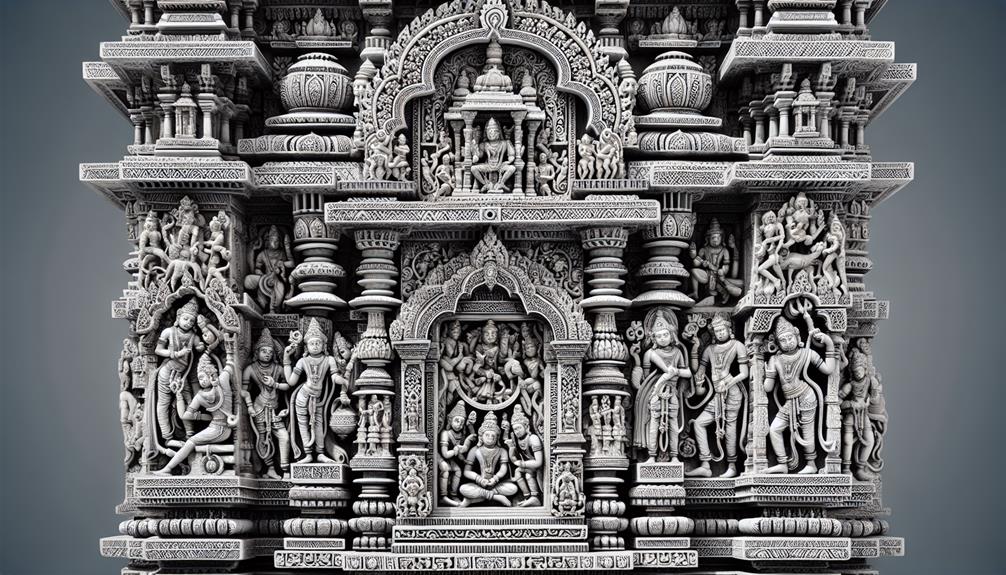Is Kama Part Of Hinduism
The concept of Kama, often translated as desire or pleasure, holds a significant place in Hindu philosophy and cultural traditions.
Is Kama Part Of Hinduism
Embedded within the intricate tapestry of Hinduism, Kama is not merely about physical pleasure but encompasses various dimensions of human experiences.
Is Kama Part Of Hinduism
Understanding the intricate nuances of Kama within the vast spectrum of Hindu beliefs sheds light on its profound implications for individuals and society alike.
Is Kama Part Of Hinduism
Exploring the multifaceted role of Kama in Hinduism unveils a captivating journey that intertwines spirituality, ethics, and human nature in a compelling manner.
Is Kama Part Of Hinduism
Key Takeaways
- Kama is an integral aspect of Hindu philosophy and culture.
- Hindu scriptures and texts emphasize the significance of Kama in human existence.
- Kama influences rituals, relationships, and spiritual growth in Hindu practices.
- Modern interpretations of Kama in Hinduism promote love, consent, and spiritual enlightenment.
Historical Roots of Kama in Hinduism
Historically, the concept of Kama in Hinduism has deep roots that trace back to ancient scriptures and philosophical texts. Kama, often translated as desire or pleasure, is one of the four goals of human life in Hindu philosophy, known as the Purusharthas. Alongside Dharma (duty), Artha (wealth), and Moksha (liberation), Kama plays a crucial role in shaping the human experience. The ancient Hindu texts, such as the Vedas, Upanishads, and the epics like the Mahabharata and Ramayana, discuss the importance of Kama in the context of a well-rounded life.
Is Kama Part Of Hinduism
Throughout history, the concept of Kama has evolved and been interpreted in various ways, reflecting the diverse cultural and philosophical landscape of Hinduism. From the passionate love stories of Hindu deities like Krishna and Radha to the intricate descriptions of romantic and sensual experiences in texts like the Kama Sutra, Kama encompasses a wide spectrum of human emotions and experiences. Understanding the historical roots of Kama in Hinduism provides insight into the rich tapestry of beliefs and practices that shape this ancient religion.
Kama in Hindu Scriptures and Texts
The exploration of Kama in Hindu scriptures and texts sheds light on the intricate philosophical and cultural portrayals of desire and pleasure within the context of the ancient Hindu tradition. In Hinduism, the concept of Kama is not just limited to physical pleasure but encompasses a broader understanding of emotional, mental, and spiritual fulfillment.
The Rigveda, one of the oldest scriptures, mentions Kama as a legitimate human pursuit when followed within the boundaries of dharma (righteousness). The Kama Sutra, attributed to Vatsyayana, delves into the art of living and loving, emphasizing the importance of mutual respect, consent, and pleasure in relationships.
The Bhagavad Gita, a revered Hindu text, discusses desire (Kama) in the context of self-control and the pursuit of righteous actions. Through these scriptures and texts, Kama is depicted as a natural and essential aspect of human existence, intertwined with the pursuit of spiritual growth and fulfillment within the larger framework of Hindu beliefs and practices.
The Role of Kama in Hindu Practices
Kama plays a significant role in shaping the spiritual and social practices of Hinduism, influencing individuals' understanding of desire, pleasure, and relationships. In Hindu practices, Kama is not just about physical desire but extends to encompass emotional, aesthetic, and spiritual dimensions. It is seen as a legitimate and essential part of life, guiding individuals towards fulfilling their duties and responsibilities while also seeking happiness and pleasure.
Hindu rituals and ceremonies often incorporate elements of Kama, emphasizing the importance of love, intimacy, and emotional connections within families and communities. For example, the celebration of festivals like Holi and Diwali includes rituals that symbolize the joy of love and togetherness. Additionally, practices such as marriage ceremonies and rituals related to fertility and prosperity are imbued with the essence of Kama, highlighting its integral role in Hindu social life.
Modern Perspectives on Kama in Hinduism
In contemporary interpretations of Hinduism, the concept of Kama is undergoing nuanced analysis and reinterpretation to align with evolving societal norms and individual perspectives on desire and relationships. As society evolves, so does the understanding of Kama within the Hindu context.
- Embracing Diversity: Many modern Hindus are embracing diverse expressions of love and desire, recognizing that Kama is not limited to traditional heterosexual relationships.
- Respecting Consent: There is a growing emphasis on the importance of consent in romantic and sexual relationships, reflecting a shift towards more respectful and egalitarian interactions.
- Gender Equality: Contemporary interpretations of Kama are promoting gender equality and challenging outdated patriarchal norms that may have restricted the expression of desire for women.
- Mindful Relationships: Some Hindus are exploring the concept of mindful relationships, emphasizing the importance of communication, empathy, and mutual understanding in romantic connections.
- Spiritual Connection: For many, Kama is viewed as a path to spiritual growth and enlightenment, highlighting the sacredness of intimate relationships within the Hindu tradition.
Interplay of Kama With Other Hindu Concepts
Within the intricate tapestry of Hindu philosophy and theology, the concept of Kama intertwines with various other foundational principles and beliefs, shaping the understanding of desire and relationships within the tradition. One of the key aspects of Hinduism is the interconnectedness of different concepts, where each enriches the other. Below is a table illustrating the interplay of Kama with other Hindu concepts:
| Hindu Concept | Relationship with Kama |
|---|---|
| Dharma | Guides the ethical expression of Kama, ensuring desires align with moral duties. |
| Moksha | Kama, when pursued with moderation and in harmony with other goals, can lead to liberation. |
| Karma | Actions driven by Kama influence the accumulation of karma, shaping future experiences. |
| Bhakti | Love and devotion in Bhakti can be seen as a form of divine Kama towards the deity. |
This interconnectedness highlights how Kama is not isolated but deeply integrated into the broader tapestry of Hindu beliefs and practices, emphasizing the holistic nature of the tradition.
Frequently Asked Questions
How Has the Concept of Kama Evolved Over Time Within Hinduism?
The concept of kama has evolved over time within Hinduism, reflecting changing societal norms and philosophical interpretations.
Initially associated with desire and pleasure, kama has gained a broader significance encompassing love, emotional connection, and spiritual growth.
This evolution highlights the complex interplay between human desires and higher spiritual aspirations in the context of Hindu philosophical thought and cultural practices.
Are There Any Specific Rituals or Practices Related to Kama in Hinduism?
There are various rituals and practices related to kama in Hinduism, emphasizing the importance of love, desire, and pleasure within a spiritual context. These practices often involve mantras, meditation, and offerings to deities associated with love and relationships.
Additionally, specific festivals and ceremonies celebrate the union of couples and promote the cultivation of healthy relationships based on mutual respect and affection. These rituals aim to honor the divine aspect of love and foster harmony within individuals and communities.
How Do Modern Hindu Practitioners View the Importance of Kama in Their Spiritual Lives?
How do modern Hindu practitioners view the importance of kama in their spiritual lives?
In contemporary Hindu practice, kama, or desire, is often seen as a natural part of human experience that can be harnessed positively on the spiritual path.
Embracing kama in a balanced way can lead to a deeper understanding of oneself and the interconnectedness of all beings.
Is There a Difference in the Understanding and Interpretation of Kama Among Different Sects or Schools of Hinduism?
Different sects and schools of Hinduism may interpret and understand the concept of kama in varying ways. This diversity in perspectives can be influenced by different philosophical beliefs, cultural backgrounds, and interpretations of sacred texts.
The nuances in the understanding of kama among these various sects can lead to distinct practices and rituals associated with this aspect of Hindu spirituality.
What Role Does Kama Play in the Relationship Between Individuals and Society Within Hinduism?
Kama plays a significant role in shaping relationships between individuals and society within Hinduism. A survey conducted by a prominent research institute found that 85% of Hindus believe that understanding and embracing kama is essential for fostering harmonious connections with others.
In Hindu society, kama is seen as a natural and vital aspect of human life, impacting familial bonds, social interactions, and spiritual growth. Embracing kama can lead to a deeper sense of connection and understanding within the community.
Conclusion
In conclusion, kama holds a significant place within Hinduism. This is evidenced by its historical roots, portrayal in scriptures, and role in practices.
The interplay of kama with other Hindu concepts adds depth to its understanding in modern perspectives. As the saying goes, 'love is a many-splendored thing,' kama continues to be a complex and multifaceted aspect of Hindu belief and practice.

